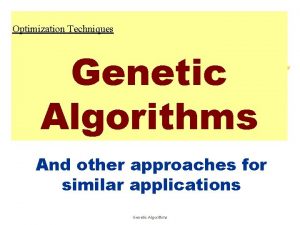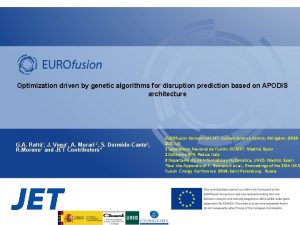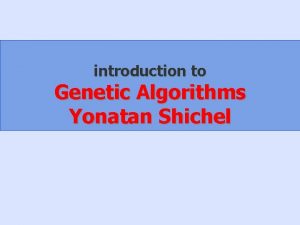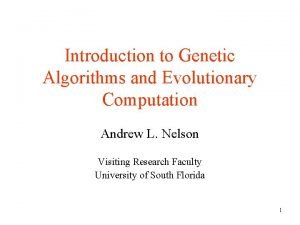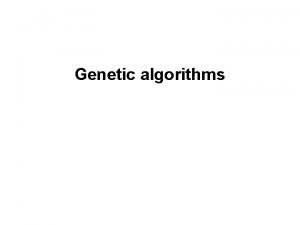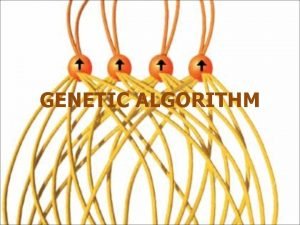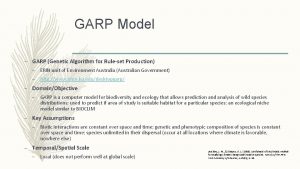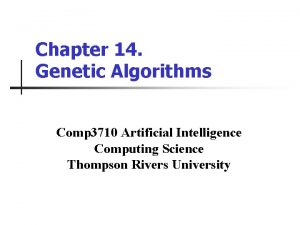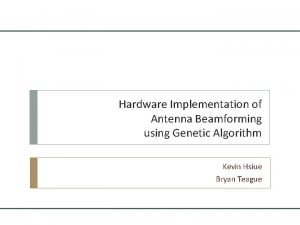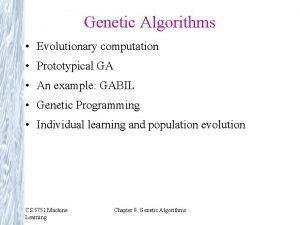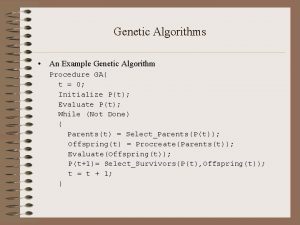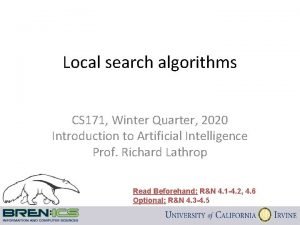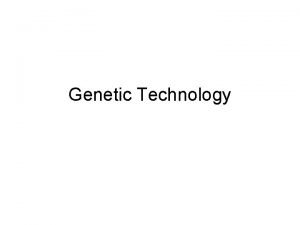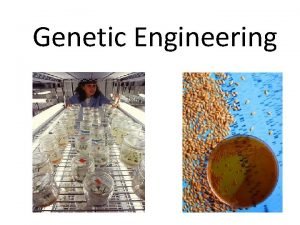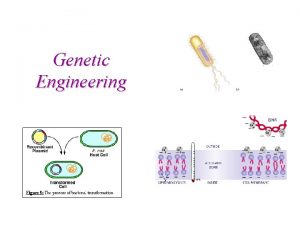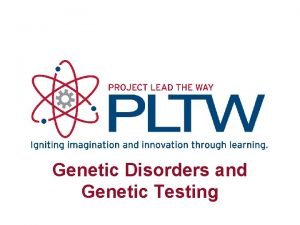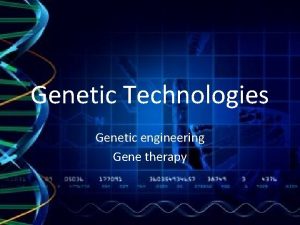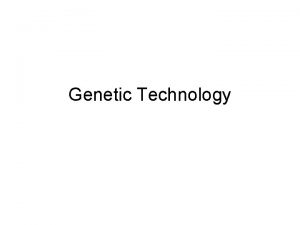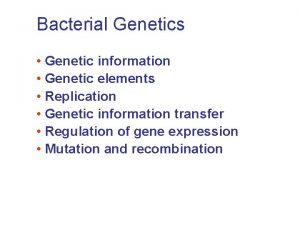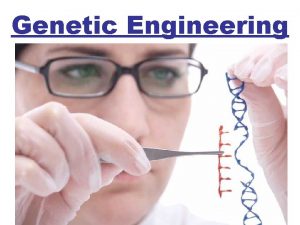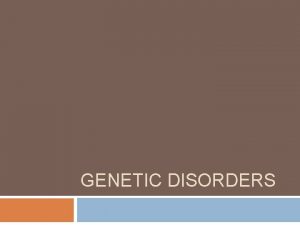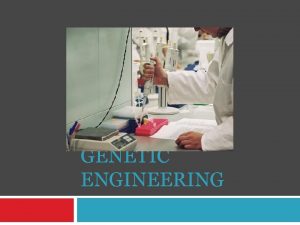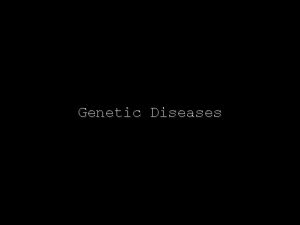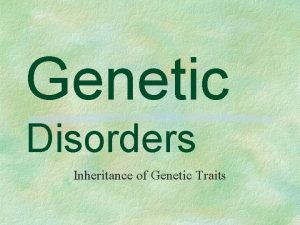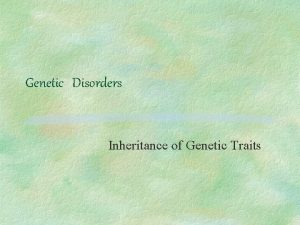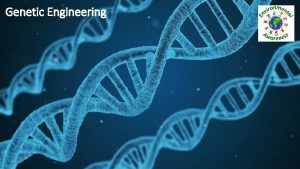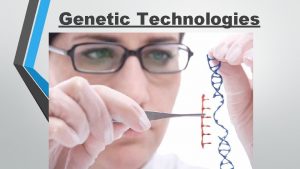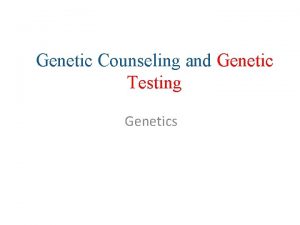GA Genetic Algorithm Genetic Algorithm Introduction Algorithm GA





















- Slides: 21

GA Genetic Algorithm

Genetic Algorithm ¬Introduction ¬Algorithm ¬GA Operations ¬Chromosome representation ¬Fitness function ¬Demonstration of Lib. GA


Genetic algorithm and application ¬ Holland initially introduced the genetic algorithm (GA), which is a global search technique (Holland, 1975). ¬ GA has received much attention and was applied successfully in many research fields over the last decade. ¬ GA explores the solution space using concepts taken from natural genetics and evolution theory. ¬ The search algorithm analyses and extracts superior evolving information from the search space, and guides the search in a pre-specified direction.

GA Algorithm Step 1. Generate a random initial population of chromosomes of size P. Step 2. Encode all chromosomes and evaluate the objective function of their corresponding candidate solutions. Step 3. Determine the fitness values of the chromosomes using the predetermined objective function. Step 4. If the elitism policy is employed, insert the best chromosomes into the new generation pool.

GA Algorithm Step 5. Choose a pair of parent chromosomes from the current population without replacement. Apply the crossover and mutation operators to yield a pair of new chromosomes. Step 6. Insert the new chromosomes into the new population. If the new population is smaller than P, return to Step 5. Step 7. If the pre-specified stopping criterion has been met, go Step 8; otherwise, return to Step 2. Step 8. Select and decode the overall best chromosome to be the final solution.

GA Operations The basic operations of GA – Reproduction – Selection – Crossover – Mutation

Reproduction If the elitism policy is employed, insert the best chromosomes into the new generation pool. The chromosomes with higher fitness are more likely to become parents of new chromosomes. The reproduction gap defined in the GA configuration file determines the proportion of elite chromosomes. The best chromosomes in the last generation are copied directly into the next generation.

Selection The selection policy employed commonly is a combination of the rotating roulette wheel strategy and the elite strategy. The elite strategy can force the best surviving chromosomes, based on the fitness values of the current generation, into the next generation.

Crossover Lib. GA provides ten crossover methods, only “ORDER 1”, “ORDER 2”, “PMX” and “CYCLE, ” which are suited to permutation processing, are employed here. The procedures of each method are briefly described below. The crossover operation is processed whether or not it is determined by a value generated randomly. If the value exceeds the crossover rate that was established in the configuration file of GA parameters, then the clone operation, rather than the crossover operation, is performed.

Order 1 Initially, select two random crossover points. Then, the offspring inherits the elements between the two crossover points from the selected parent, in the order and position in which the parent appeared. The remaining elements are inherited from the other parent in the order in which they appeared in that parent, beginning with the first position, followed by the second crossover point, and skipping over all elements that are already present in the offspring.

Order 2 Select four random crossover points as key positions to determine the order in which these genes appear in one parent and are subsequently imposed on the other parent to produce two offspring.

PMX Randomly select two crossover points. Then, the offspring inherits the elements between the two starting positions in one of the parents. Each element between the two crossover points of the other parent is mapped to the position of this element in the first parent. Then, the remaining elements are inherited from the other parent.

CYCLE Randomly select a crossover point as a cycle starting point. The offspring inherits the element at the starting point of the selected parent. The element that is located in the corresponding position in the other parent cannot then be placed in this position, and thus it takes a position in the selected parent from which the offspring then inherits it. This procedure is repeated until the initial item in the unselected parent is encountered, completing the cycle. The offspring inherits from the unselected parent any elements that are not yet present.

Mutation The swap method is normally used as the mutation operation. The swap procedure randomly selects two points to determine the two changing points of the selected parent. The mutation operation is processed whether or not it is determined by a value generated randomly. If the value exceeds the mutation rate established in the configuration file of GA parameters, no mutation is performed and the selected parent is passed directly into the new generation.

The demonstration of crossover operation Bit string 1 0 0 1 1 Parent 1 7 4 8 1 3 6 9 10 2 5 Offspring 7 3 8 1 10 6 4 9 2 5 Parent 2 3 5 2 8 7 10 4 1 6 9

The demonstration of mutation operation Parent 1 5 4 8 | 1 7 2 3 | 10 6 9 Offspring 5 4 8 | 3 7 2 1 | 10 6 9

Chromosome representation ¬ Integers are employed to represent the operation of assigning task to workstation in successive number of 1, 2, …, N, respectively. ¬ A candidate solution can be encoded as a string by a permutation of {1, 2, …, N} to form a chromosome.

Chromosome representation Encoding Example: ‘ 2 -1 -4 -3 -5 -6 -8 -7 -9’ is one possible chromosome in the example of 3 tasks × 3 machines shown as follows: W 1 W 2 W 3 a 1 4 7 b 2 5 8 c 3 6 9

Chromosome representation Decoding Example: String of ‘ 1 -4 -5 -2 -9 -6 -8 -7 -3’ can be decoded as: Ø Ø Task a is assigned to Workstation W 1 (String 1), Task b to Workstation W 2 (String 5), and Task c to Workstation W 3 (String 9). Strings 4 (Task a), 2 (Task b), 6 (Task c), 8 (Task b), 7 (Task a), and 3 (Task c) are dummies.

Fitness function ¬ A weighting function (Eq. 9) is derived from the five system objective functions to evaluate the fitness values (FV) of a given chromosome. ¬ In Eq. (9), wi represents the weighting values of objectives. ¬ A smaller FV means that the chromosome is more likely to survive to the next generation.
 Genetic programming vs genetic algorithm
Genetic programming vs genetic algorithm Genetic programming vs genetic algorithm
Genetic programming vs genetic algorithm Genetic drift vs gene flow
Genetic drift vs gene flow What is gene flow and genetic drift
What is gene flow and genetic drift What is the difference between genetic drift and gene flow
What is the difference between genetic drift and gene flow Human genetics concepts and applications 10th edition
Human genetics concepts and applications 10th edition Single point crossover in genetic algorithm
Single point crossover in genetic algorithm Ga lottery predictions
Ga lottery predictions Single point crossover in genetic algorithm
Single point crossover in genetic algorithm Fitness function in genetic algorithm
Fitness function in genetic algorithm Genetic algorithm heuristic
Genetic algorithm heuristic Single point crossover in genetic algorithm
Single point crossover in genetic algorithm Genetic algorithm for rule set production
Genetic algorithm for rule set production Fitness function in genetic algorithm
Fitness function in genetic algorithm Genetic algorithm python
Genetic algorithm python Gabil genetic algorithm
Gabil genetic algorithm Schema theorem in genetic algorithm example
Schema theorem in genetic algorithm example Genetic algorithm
Genetic algorithm Genetic algorithm for stock prediction
Genetic algorithm for stock prediction Essay structure
Essay structure Introduction algorithm
Introduction algorithm Difference between a* and ao* algorithm
Difference between a* and ao* algorithm






